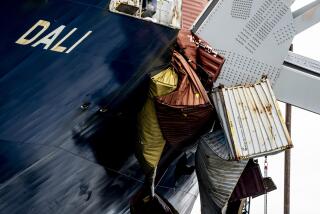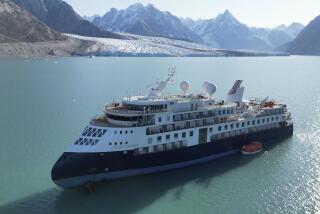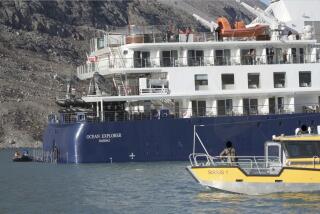Tow line is attached to beached Shell oil barge off Alaska
Rescuers attached a tow line Sunday evening to an oil barge stranded against the rocky shore of an island off the coast of Alaska.
But the delicate next steps, in which rescuers try to pull the slightly damaged barge to safety 30 miles away without losing any of its oil, were still uncertain.
The Kulluk, a 266-foot barge fresh off its inaugural drilling expedition in the Arctic for Shell, broke free from its tow lines in rough weather and hit ground submerged just off the shoreline of Sitkalidak Island on Dec. 31. The barge remained upright but was partially damaged by waves.
The plan is for a tow ship, the Aiviq, to pull the Kulluk -- which does not have a propulsion system -- to safe harbor in Kiliuda Bay, Alaska.
Response officials told the Los Angeles Times on Sunday evening that the Aiviq would be the ship towing the Kulluk and that a 10-member recovery team remained aboard the barge. Stephen Doolan, a spokesman for the governmentâs response effort, would not confirm any further details about next steps. The decision to make the tow was at the discretion of the crew on site, he said.
None of the Kullukâs fuel appears to have leaked and its fuel tanks appear to be intact, but officials said at least one of the protective âvoidsâ that separates the shipâs outer and inner hull has filled with water.
The Aiviq, too, has had problems -- its four engines failed while towing the Kulluk before the bargeâs beaching last week, and officials said the cause of Aiviqâs previous technical problems had not been conclusively determined.
A rescue team aboard the Kulluk has been evaluating the rig for damage. Officials said the bargeâs main tow wires appeared sound, which would allow the barge to be dragged back out to sea with the rescue team -- about 10 people -- remaining aboard.
Rescue officials also planned to lay down oil boom to Kodiak Island, but a salmon stream flowing into Ocean Bay complicates those efforts. The Kullukâs fuel will likely remain aboard, as officials were concerned that removing the fuel might be more dangerous than leaving it inside the bargeâs tanks.
More to Read
Sign up for Essential California
The most important California stories and recommendations in your inbox every morning.
You may occasionally receive promotional content from the Los Angeles Times.











